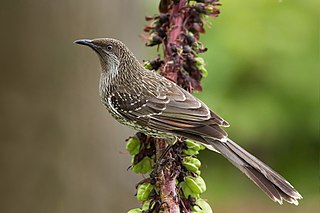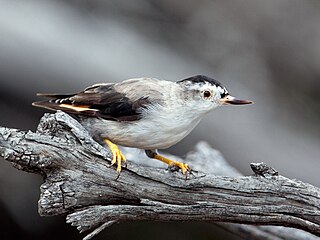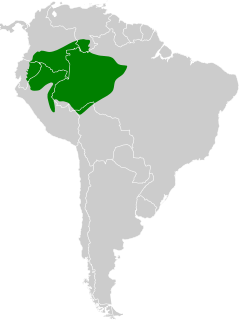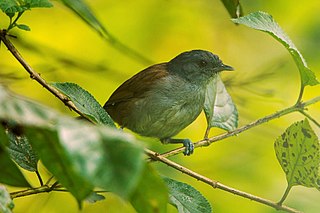
The family Cisticolidae is a group of about 160 warblers, small passerine birds found mainly in warmer southern regions of the Old World. They were formerly included within the Old World warbler family Sylviidae.

The red wattlebird is a passerine bird native to southern Australia. At 33–37 cm in length, it is the second largest species of Australian honeyeater. It has mainly grey-brown plumage, with red eyes, distinctive pinkish-red wattles on either side of the neck, white streaks on the chest and a large bright yellow patch on the lower belly. The sexes are similar in plumage. Juveniles have less prominent wattles and browner eyes. John White described the red wattlebird in 1790. Three subspecies are recognized.

Anthochaera is a genus of birds in the honeyeater family. The species are native to Australia and include the little wattlebird, the red wattlebird, the western wattlebird, and the yellow wattlebird. A molecular phylogenetic study has shown that the regent honeyeater also belongs in this genus.

The little wattlebird, also known as the brush wattlebird, is a passerine bird in the honeyeater family Meliphagidae. It is found in coastal and sub-coastal south-eastern Australia.
The Handbook of the Birds of the World (HBW) is a multi-volume series produced by the Spanish publishing house Lynx Edicions in partnership with BirdLife International. It is the first handbook to cover every known living species of bird. The series was edited by Josep del Hoyo, Andrew Elliott, Jordi Sargatal and David A. Christie.

The varied sittella is a small, around 10–11 cm long, songbird native to Australia. It is also known as the Australian nuthatch, orange-winged sittella and the barkpecker.

The white-spotted mannikin is a small passerine bird in the family Estrildidae. It is endemic to southern New Guinea.

The blue-banded kingfisher, is a species of kingfisher in the subfamily Alcedininae. Its natural habitats are subtropical or tropical moist lowland forest, subtropical or tropical mangrove forest, and rivers. It's a small, rather dark kingfisher. Male is highly distinctive, with a broad blue-green band across a white chest. Female is very different, with an all-orange belly; distinguished from Common Kingfisher by overall duller, darker coloration and the lack of a bright white-and-orange patch behind the eye, its call is piercing similar to the common kingfisher

The yellow wattlebird is a species of bird in the honeyeater family Meliphagidae. Other names include the long wattlebird or Tasmanian wattlebird.

The western yellow robin is a species of bird in the Australasian robin family, Petroicidae, native to Australia. Described by John Gould in 1838, the western yellow robin and its Australian relatives are not closely related to either the European or American robins, but they appear to be an early offshoot of the Passerida group of songbirds. Ranging between 13.5 and 15.5 cm long, it has grey upperparts, and a grey breast and head, broken by whitish streaks near the bill and below the eye, with a conspicuous yellow belly. The sexes are similar in appearance. Two subspecies are recognized: subspecies griseogularis, which has a yellow rump, and subspecies rosinae with an olive-green rump.

Melanodryas is a genus of passerine birds in the Australasian robin family Petroicidae.

The reddish-winged bare-eye is a species of insectivorous passerine bird in the antbird family, Thamnophilidae. It is found in Bolivia, Brazil, Colombia, Ecuador, Peru, and Venezuela. Its natural habitat is subtropical or tropical moist lowland forests.

Pseudoalcippe is a genus of passerine birds in the family Sylviidae that are found in Africa.

Tregellasia is a genus of birds in the family Petroicidae that are found in Australia and New Guinea.

Oreoicidae is a newly recognized family of small insectivorous songbirds from New Guinea and Australia, commonly known as the Australo-Papuan bellbirds. The family contains three genera, each containing a single species: Aleadryas, which contains the rufous-naped bellbird; Ornorectes, which contains the piping bellbird; and Oreoica, which contains the crested bellbird.

The silver-throated bushtit or silver-throated tit is a species of bird in the family Aegithalidae. It is widely spread throughout central and eastern China and south towards Yunnan. Its natural habitat is temperate forests.

Spilopelia is a genus of doves that are closely related to Streptopelia, yet distinguished from them by differences in morphology and behavior. Some authors have argued that Stigmatopelia is the valid name as it appears in an earlier line although also erected by the Swedish zoologist Carl Sundevall, but Richard Schodde and Ian J. Mason in their zoological catalogue of Australian birds chose Spilopelia citing clause 24(b) of the International Code of Zoological Nomenclature (ICZN) which supports the decision of the first reviser. The name Spilopelia combines the Ancient Greek spilos meaning "spot" and peleia meaning "dove".
Frederick Bulstrode Lawson Whitlock (1860-1953) was an ornithological writer and oölogist, active in England and across Western Australia.

Ianthocincla is a genus of passerine birds in the family Leiothrichidae.




















